Top speed 639 km/h Retired 1975 Wingspan 43 m | Introduced 1957 Length 38 m First flight August 16, 1952 | |
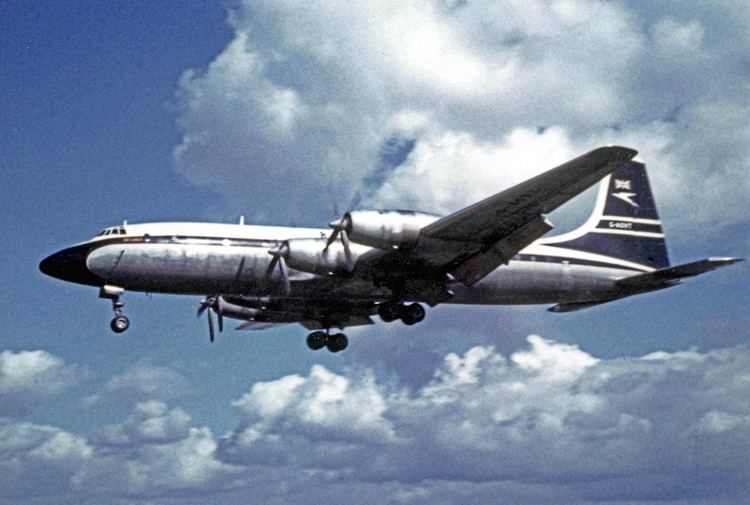 | ||
The Bristol Type 175 Britannia was a British medium-to-long-range airliner built by the Bristol Aeroplane Company in 1952 to fly across the British Empire. During development two prototypes were lost and the turboprop engines proved susceptible to inlet icing which delayed entry into service while solutions were sought.
Contents
- The bristol britannia story
- Origins
- Prototypes and production
- Related development
- Operational history
- Bristol Model 175
- Series 100
- Series 200
- Series 250
- Series 300
- Series 310
- Civilian operators
- Military operators
- Accidents and incidents
- Survivors
- Notable appearances in media
- Specifications Series 310
- References
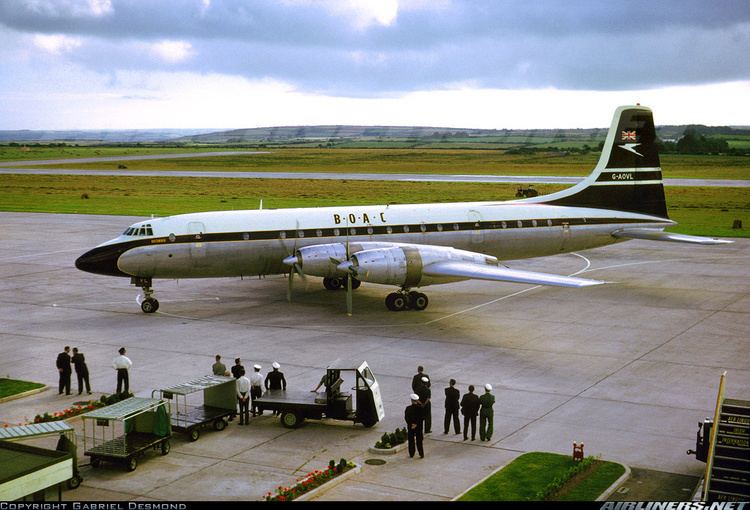
By the time development was completed, "pure" jet airliners from France, United Kingdom and the United States were about to enter service, and consequently, only 85 Britannias were built before production ended in 1960. Nevertheless, the Britannia is considered one of the landmarks in turboprop-powered airliner design and was popular with passengers. It became known by the title of "The Whispering Giant" for its quiet exterior noise and smooth flying, although the passenger interior remained less tranquil.
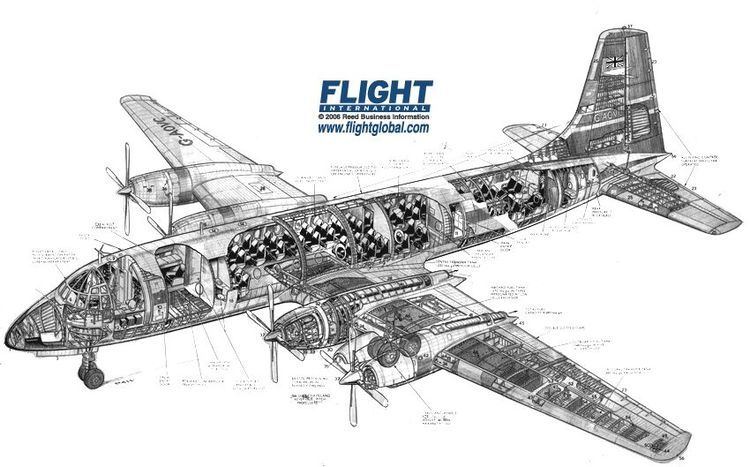
Canadair purchased a licence to build the Britannia in Canada, adding another 72 variants. These were the stretched Canadair CL-44/Canadair CC-106 Yukon, and the greatly modified Canadair CP-107 Argus patrol aircraft.
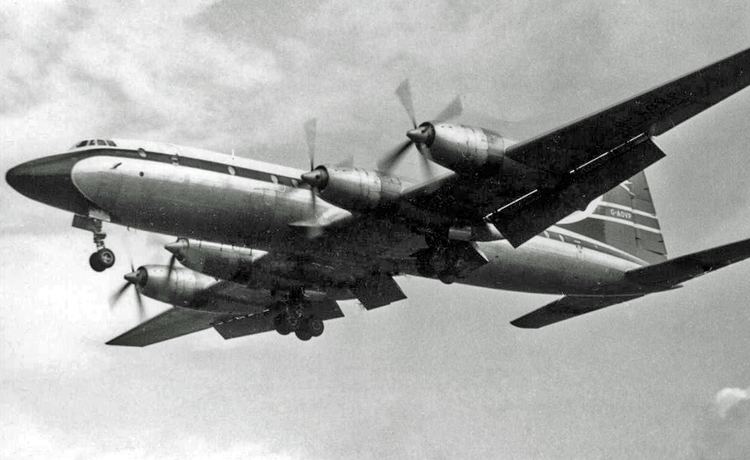
The bristol britannia story
Origins
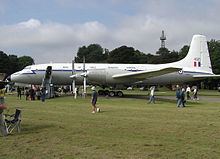
In 1942, during the Second World War, Allied aircraft construction saw the UK of necessity concentrating on heavy bombers, leaving the production of transport aircraft to the USA. This would have left the UK with little experience in transport construction at the end of the war, so in 1943, a committee under Lord Brabazon of Tara investigated the future of the British civilian airliner market. The Brabazon Committee called for several different aircraft to be developed to specifications composed by the committee for roles felt to fulfil Britain's civilian aviation needs.
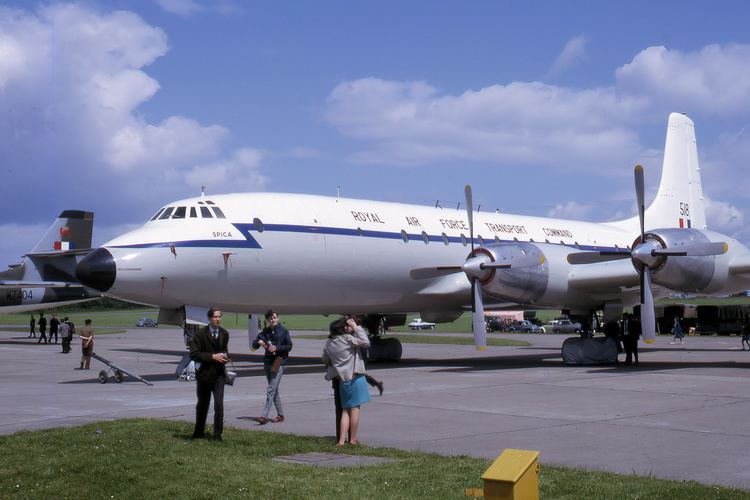
Bristol won the Type I and Type III contracts, delivering their Type I design, the Bristol Brabazon in 1949. The requirement for the 1946 British Overseas Airways Corporation (BOAC) Medium Range Empire (MRE) Requirements coincided with the Type III, Specification C.2/47, issued in April 1947 by the Minister of Supply. The specifications called for an airliner capable of carrying 48 passengers and powered with Bristol Centaurus radial engines or Napier Nomad turbo-compound Diesel engine. Turboprop options were also considered, but they were so new that Bristol could not guarantee the performance specifications.
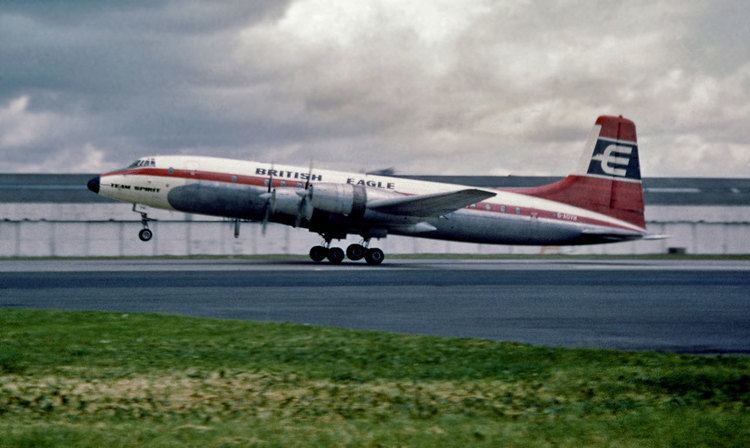
Although in-company Proposals "X" for conversions of Lockheed Constellations to Centaurus 662 powerplants or "Y" for licence production of the Constellation were considered in late 1946, BOAC decided that an entirely new design was preferred. After wrangling between the Ministry of Supply and BOAC over costs, the go-ahead for the project assigned the company designation Model 175 was given in July 1948. Three prototypes were ordered as Mk 1 (Centaurus 662), with the second and third prototypes designated the Mk 2 (to be convertible to Bristol Proteus turboprops, then under development).
In October 1947, with work already underway, Bristol had settled on a Centaurus-powered design, with an all-up weight of 103,000 lb (47,000 kg) and a payload of 13,300 lb (6,000 kg). The anticipated Karachi-Cairo run necessitated a 48-seat limit with a requirement for sufficient fuel for the lengthy stage. On 5 July 1949, the Ministry of Supply ordered five prototypes to this specification with the understanding that BOAC would contract for an additional 25 production examples. BOAC purchased options for 25 aircraft on 28 July, to be powered initially with the Bristol Centaurus engine but to be re-fitted with the Bristol Proteus when available. In November 1948, the Type 175 design was revised again to accommodate 74 passengers and a longer span wing in a contemplated long-range version aimed at long-haul Empire and transatlantic routes rather than the medium-haul Empire routes originally planned. On reflection, BOAC decided that only a Proteus-engined aircraft was worth working on, necessitating a further redesign with Bristol eliminating the Centaurus option. Senior figures within BOAC such as the Deputy Chairman Whitney Straight, however, considered the Proteus engine to be "an obsolete contraption". Despite BOAC's desire to have a turboprop engine, the Type 175 project was contingent on the Proteus passing a 150-hour Type Test.
Prototypes and production
The name, "Britannia" was chosen in April 1950 with Britannia 101 the designation for first two prototypes powered by the early series Proteus 625, the follow-up from the 600 series engine that had successfully completed its type trials. The first prototype, registered G-ALBO, with Bristol Chief Test Pilot A.J. "Bill" Pegg at the controls, flew for the first time on 16 August 1952 at Filton Aerodrome. The maiden flight was eventful as the over-sensitive flying controls led to a wild pitching before Pegg restored control. During the landing approach, smoke filled the cockpit and the main undercarriage bogie was stuck in its cycle, only fully deploying seconds before landing. The "snags" proved to be minor and by September, the prototype was cleared to perform at the 1952 SBAC Display at Farnborough where spectators commented on the "quietness" of the giant airliner. In November 1952, Popular Science reported that by 1954 BOAC would have 25 of these aircraft on routes such as London-to-Tokyo over the Arctic and North Pole. However, in 1953 and 1954, three de Havilland Comets crashed without explanation, and the Air Ministry demanded the Britannia undergo lengthy tests. Further delays were attributed to teething problems with the engine resulting in the loss in December 1953 of the second prototype, G-ALRX, caused by a failed reduction gear that led to an engine fire and the aircraft landing on the mudflats of the Severn Estuary. Resolving easily avoidable inlet icing issues - by selecting a slightly different cruising height than that specified - which were exaggerated by BOAC destroying the Britannia's sales prospects and delaying the Britannia's introduction by two years, also took time. The first prototype G-ALBO was subsequently modified to more closely approximate a production standard but was retained by the company to undergo engine testing and development.
Bristol revised the design into a larger transatlantic airliner for BOAC, resulting in the Series 200 and 300, with the Britannia 300LR (Long-Range) seen as "eminently suitable" for BOAC's services between London and Sydney. Qantas had been considering purchasing a fleet of Britannia aircraft, but the extended development time had worn away the advantage the aircraft would hold until newer aircraft such as the Douglas DC-8 and de Havilland Comet 4 came onto the market. Route-proving trials continued through 1955, although orders were on the books from El Al and Canadian Pacific Air Lines as well as BOAC's standing order.
The purchase price paid by BOAC for each Britannia 100-series aircraft agreed on in 1955 was £768,000.
During the first eight months of operational trials, a total of 16 in-flight engine failures and 49 unscheduled engine changes punctuated the ongoing engine dilemma and delayed the in-service date until February 1957, roughly two years late. The Britannia received a fair amount of attention in both the popular press and the British House of Commons, especially when it was revealed that BOAC had contemplated fitting Rolls-Royce Tynes to their fleet of Douglas DC-7s as an interim measure until the Britannia was cleared for service.
Aviation historian Peter Pigott summarised the impact of the delays:
Related development
In 1954, a licence was issued to Canadair to build the derivative Canadair CL-28/CP-107 Argus, and the Canadair CL-44/Canadair CC-106 Yukon. Based on the Britannia, the design of the Argus maritime patrol and anti-submarine warfare aircraft was optimised for endurance on long-range patrol, not speed, and used four Wright R-3350-32W Turbo-Compound engines that used less fuel at low altitude. Unlike its Britannia forebear, the Argus was a hybrid using the Britannia wings, tail surfaces and landing gear matched to a "purpose-built", unpressurised fuselage. Another significant departure was being "Americanized", substituting North American materials and standard parts for the British ones. The interior was well equipped with the tools to conduct anti-submarine warfare: navigation, communication and tactical electronic equipment along with weapon loads that included bombs, torpedoes, mines and depth charges. A total of 33 Argus aircraft were built in two series (Mk 1 and Mk 2), serving the Royal Canadian Air Force (RCAF) and Canadian Forces from 1957 to 1982.
Canadair built 39 Canadair CL-44/Canadair CC-106 Yukon turboprop Rolls Royce Tyne-powered aircraft, comprising 12 CC-106 Yukon for the RCAF and 27 CL-44D4 passenger/cargo variants for the civil market, most of which were used as freighters. Four CL-44D4s were converted as CL-44Js with lengthened fuselages for service with the Icelandic "budget" airline Loftleiðir. The CL-44D4s were all built with swing-tails to allow straight-in cargo loading and served with a variety of carriers, most notably Flying Tiger Line. The similar CC-106 Yukon was used by the RCAF in a solely passenger configuration. A final unique "one-off" development was the Conroy Skymonster, nicknamed Guppy, based on a Canadair CL-44D4 N447T. The most prominent modification was an enlarged fuselage, like the Mini Guppy which was produced by Jack Conroy's previous company, Aero Spacelines. After a long operational career as a freighter, the Guppy was stored at Bournemouth Airport in 2003 and has recently been sold.
Operational history
Following a long period of uneventful development flying trials and the fitting of a modified Proteus 765 series engine that greatly reduced breakdowns, a full Certificate of Airworthiness was awarded at the end of 1955. The first two Model 102s were delivered to BOAC on 30 December 1955 for crew training. The Model 102 began scheduled service on 1 February 1957 with a BOAC flight from London to Johannesburg, flights to Sydney following in March and to Tokyo in July. By August 1957, the first 15 Model 102 aircraft had been delivered to BOAC. The last 10 aircraft of the order were built as Series 300 aircraft for transatlantic flights. In April 1959, a Model 102 Britannia was leased by BOAC to Ghana Airways for flights between Accra and London, and several more Britannias were purchased by the airline in the early 1960s. The Model 102 was eventually made available to other BOAC associates, including Cathay Pacific, Central Africa, East African, Nigeria and Malayan airlines.
The next production series was based on the long-range, mixed passenger/freight Model 200 series that was intended for civil airline use but ultimately Bristol offered the series to the Royal Air Force (RAF) instead. The production series of three Model 252 and 20 Model 253 aircraft were purchased by RAF Transport Command in 1959, assigned the designation Britannia C.2 (first Model 252 series) and C.1 (Model 253 series). Those in RAF service were allocated the names of stars, such as "Arcturus", "Sirius" and "Vega". On retirement from the RAF in 1975, many Model 200 series were subsequently used by independent civil operators for cargo operations, harkening back to their original intended role.
Although the Bristol Model 302 was built first as part of the original BOAC order, BOAC released this series to other airlines; Aeronaves de Mexico took two Model 302s which entered service in December 1957. The 18 Bristol Britannia 312s for BOAC were delivered from September 1957 with its service introduction on the first-ever non-stop flight from London to Canada on 19 December 1957. In late December 1957 BOAC began regular Britannia flights from London to New York. Other airlines, such as Israel's El Al, used the Britannia on transatlantic routes. In 1959 BOAC started flying the Britannia across the Pacific to Tokyo and Hong Kong, thus extending their network round the world. The westbound routing in 1959 for these intercontinental BOAC Britannia flights between the U.K. and Asia was London-New York-San Francisco-Honolulu-Wake Island-Tokyo-Hong Kong.
On 1 April 1958 Canadian Pacific Air Lines took delivery of the first of six Model 314 Britannias, with an additional two Model 324s (built to a 320 standard) arriving later and sold to Cathay Pacific in 1961. BOAC ordered seven Model 302s but never took delivery, instead they were taken on by airlines including Aeronaves de México and Ghana Airways. The main long-range series were the 310s, of which BOAC took 18 and, after deliveries began in September 1957, put them into service between London and New York City; in March 1964 BOAC owned 50 aircraft, 10 being Britannia 312s. BOAC's last scheduled Britannia flight was April 1965.
The 310 series (the Model 318) also saw transatlantic service with Cubana de Aviación starting in 1958, in spite of the Cuban Revolution the airline had a special accord with British aircraft manufacturers to maintain this model of aircraft. In 1975 Cuban Britannias were used to transport hundreds of soldiers of the Cuban Revolutionary Armed Forces to Angola in Operation Carlota, a proxy war. Cubana de Aviación continued using various Britannias until March 1990.
Most aircraft were built by Bristol at Filton but 30 were built at Belfast by Short Brothers and Harland. Due to the extended development instead of a projected production of 180 Britannias, only 80 were sold. The negative experience with the development of the Britannia caused BOAC to be more cautious towards other British-made aircraft such as the Vickers VC-10. Throughout the Britannia's lifespan, the engine icing condition remained a "continual potential hazard" that flight crews ultimately learned to manage with a "high-lo" flight regime that minimized the danger, although the problems of the Britannia can mainly be linked to that of a manufacturer undertaking an innovative airframe design matched to an unproven engine, a design syndrome that remained particularly daunting. Squadron Leader David Berry who had 5,000 hours on the type characterised his experiences as flying "Beauty and the Beast." A more fitting epitaph was recently proffered by the editors of Aeroplane as the "100 Great British Aircraft" (2008) were analysed with the Bristol Britannia counted among the "greats".
Following purchase of remaining spare parts from Royal Aircraft Establishment and Cubana, Zaïrois airlines continued to operate Bristol Britannia into the early 1990s on regular cargo flights from N'djili Airport to various destinations within the country.
Bristol Model 175
Series 100
Seventy-four passenger airliner with 114 ft (35m) fuselage and powered by four Bristol Proteus 705
Series 200
All cargo variant with a 124 ft 3 in (38 m) fuselage, BOAC option for five was cancelled, none built.
Series 250
Similar to the 200 series, but mixed passenger and freight.
Series 300
Passenger only "stretched" version of the 200 series, incorporating 123 inches (3.1 m) longer fuselage, capable of carrying up to 139 (originally 99) passengers, medium-fuel capacity.
Series 310
As 305 series, but with strengthened fuselage skin and undercarriage. Long-range fuel capacity and was originally known as 300LR.
Civilian operators
Military operators
Accidents and incidents
Fourteen Britannias were lost with a total of 365 fatalities between 1954 and 1980. The worst accident was the 1967 Nicosia Britannia disaster with a loss of life totalling 126.
Survivors
Notable appearances in media
An Aeronaves de Mexico Model 302 Britannia was the aircraft in the 1959 movie Jet Over the Atlantic; the audience is informed that the aircraft is a turboprop.
Specifications (Series 310)
Data from Britannia... Last of the Bristol Line
General characteristics
Performance
Avionics
